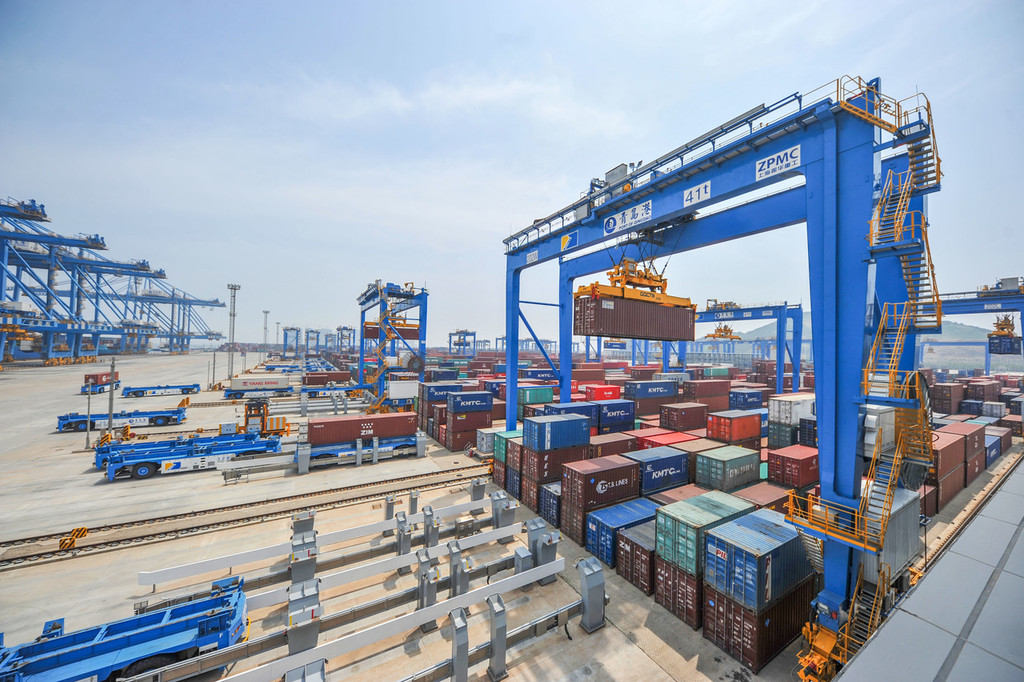Jan-Sept trade up 2.8% amid conflicts
By Zhong Nan | China Daily | Updated: 2019-10-15 03:49

Figure with markets related to BRI totals 6.65 trillion yuan, up 9.5% year-on-year
China's foreign trade maintained stable performance during the first three quarters despite trade friction with the United States, the latest customs data showed.
Looking ahead, the expansion of international trade will depend largely on the easing of trade tensions, which, left unresolved, may further dampen the global economy, according to officials and analysts.
Foreign trade of the world's second-largest economy recorded stable growth from January to September, expanding 2.8 percent year-on-year, the General Administration of Customs announced on Monday.
China's total foreign trade volume reached 22.91 trillion yuan ($3.23 trillion) in the first nine months. Exports expanded 5.2 percent while imports dropped 0.1 percent.
Despite slower global economic growth and rising trade protectionism, China's foreign trade has remained resilient due to strong domestic consumption, expansion of private businesses, tariff cuts and market diversification, said Li Kuiwen, a spokesman for the administration.
Li predicted that China's foreign trade will remain stable for the year.
The country's trade with the European Union and the Association of Southeast Asian Nations, China's top two trading partners, hit 3.57 trillion yuan and 3.14 trillion yuan, respectively, in the first three quarters, up 8.6 percent and 11.5 percent year-on-year, according to the administration data.
In the same period, trade with the US dropped 10.3 percent to 2.75 trillion yuan.
The administration noted the substantial progress that negotiating teams from the two countries have achieved in their latest round of trade talks.
"The two sides have discussed follow-up arrangements and agreed to work together toward a final agreement. This will generate a positive effect on bilateral trade," Li said.
As for the next step, the administration is closely watching with other government departments, Li added.
The consensus on a preliminary agreement reached in certain areas will not only enable manufacturers, farmers and service sector providers from both sides to regain confidence, but will also be effective in rebuilding global value and supply chains, said Ma Yu, a senior researcher at the Chinese Academy of International Trade and Economic Cooperation.
Both countries must demonstrate more willingness to reach an eventual final result, said Lu Xiang, a researcher on Sino-US relations at the Chinese Academy of Social Sciences. Trade tensions between China and the US heightened uncertainty and forced businesses to cut productivity and investments not only in the two countries, but also in other parts of the world, Lu said.
Jens Puttfarcken, president and CEO of Porsche China, said the current scenario in the global economy is creating some volatility and uncertainty, and businesses need to take actions to ease potential impact from these uncertainties as soon as possible.
"We believe that there is no alternative to global free trade," Puttfarcken said.
In the first half of 2019, Porsche delivered 42,608 vehicles to China, a year-on-year growth of 28 percent, leading the rest of its global markets. "Despite all the uncertainties, we are optimistic about our sales performance in China," he added.
Due to the China-US trade dispute, the World Trade Organization recently lowered its projection for global trade in goods to 1.2 percent for 2019 from its earlier prediction of 2.6 percent made in April. This would be the weakest growth rate since 2009.
Wei Jianguo, vice-chairman of the China Center for International Economic Exchanges, said that as trade friction did push some domestic and global companies to relocate their factories to India, Vietnam and other developing countries, China should be more proactive in further tapping markets related to the Belt and Road Initiative.
"The tendency will promote gradual 'going global' progress for domestic companies, helping diversify production origins, export markets and asset portfolios," Wei said.
China's trade with economies related to the BRI totaled up to 6.65 trillion yuan in the first three quarters of 2019, an increase of 9.5 percent year-on-year, which is 6.7 percentage points higher than the overall foreign trade growth rate during the same period.
























